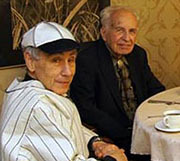On Mon. evening Sept. 15, 2014 I gave a talk at Whitney Center, a retirement community, in Hamden, Ct. I was also invited to have dinner with some of the residents where I had the privilege of meeting Dr. Robert Adair.

In 1945 at age 20 during WWII in Germany he was shot in the head and right arm, and spent a year in an army hospital. He was awarded a purple heart and a Bronze Star. Being shot in the head fortunately had no effect on his scholarly ability.He proceeded to obtain his doctorate degree in experimental nuclear physics at the Univ. of Wisc.. Later he worked at Brookhaven National Laboratory in Long Island. In 1959 he joined the faculty at Yale, serving as chair of the Physics Dept. He was elected a Fellow of the American Academy of Arts and Sciences in 1997
At this point you probably believe there is some connection between Dr. Adair and baseball. You are correct. While at Yale, Dr. Adair met Dr. Bart Giamatti, Dr. Giamatti was a Renaissance literature professor who later became president of Yale. Subsequently, Dr. Giamatti left Yale to become president of the National League and then took the position of commissioner of Major League Baseball.
At dinner, Dr. Adair told me that when Dr. Giamatti was president of the National League he approached him with three questions. Does corking a bat increase the distance a ball travels when hit by a bat? What effect does scuffing a ball have on its flight? What effect would the high altitude in Colorado have on hitting home runs? After writing technical reports answering these three questions, Dr Adair told me he earned an unusual title, Physicist to the National League, which he accepted in lieu of a consulting fee. He served in this position for two years. The position ended when his term ended. During his term he wrote a book titled The Physics of Baseball. Dr. Adair told me his book is now in its third edition and had sold over 100,000 copies. Some of the topics covered in his book are: what makes a curveball curve, what makes a knuckleball behave erratically, and what is the perfect swing. When first published in 1990, former Yale first baseman, President George Herbert Bush received a copy of Dr. Adair’s book. “’If only I had read this 44 years ago I might have batted .300,” the president wrote to Mr. Adair. ”When finished I’ll forward it to son George, owner at that time (with others) of the Rangers. They need the help.”
Another controversy in baseball needed the help of physicists. The World Umpires Assoc., the bargaining agent for major league umpires, hired Dr. Adair and six other scientists to make sense of a machine, the QuesTec Umpire Information System, designed to judge balls and strikes. The league uses the machine to evaluate umpires. ”It uses two video cameras to nominally track the ball and, in principle, tell whether a ball crosses over the plate or not,” said Mr. Adair in describing QuesTec. ”In principle, this can be done well, but it’s not easy. Judging from the patent, I have questions regarding the accuracy of this machine.”Dr. Adair is the right person to make that judgment, according to Alan M. Nathan, professor of physics at University of Illinois at Urbana-Champaign. ”He is a particle physicist,” Mr. Nathan said. ”Particle physicists are concerned with the collision of elementary particles, which we track through detectors. We look for some signal that the particle leaves at various places, and then track the trajectory. Tracking the trajectory of a baseball is a piece of cake for a particle physicist. Tracking trajectories is our bread and butter.”
Future blogs will have other stories of the wonderful evening I spent at Whitney Center
